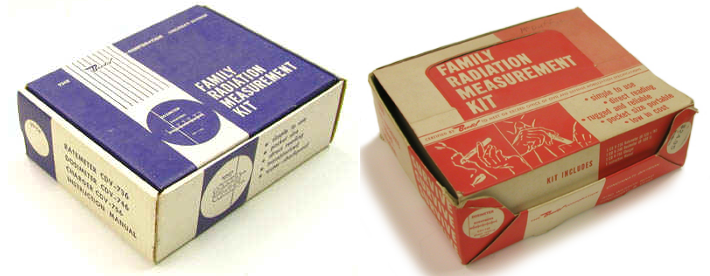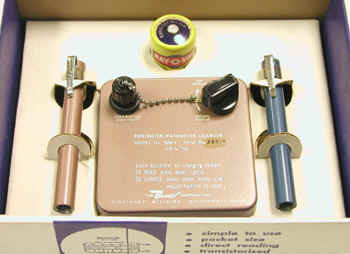Bendix Family Radiation Measurement Kit (ca. 1960-1963)
The Family Radiation Measurement Kit was produced by the Bendix Corporation of Cincinnati Ohio. The earliest reference I have found for it was in a newspaper article from August 1961. The last reference I've found dates from 1963. By then the fallout shelter boom had gone bust. Without a doubt, it filled an important need. The public had been encouraged to construct home fallout shelters but until Bendix started producing the kit, there was no commercially available radiation detection instrumentation that was both inexpensive and easy to use. The suggested retail price for the kit was $24.95—a very reasonable price for these “3 Life Savers.” These were often provided "free" of charge when you purchased a commercially available fallout shelter. The kit was both approved and recommended by the Office of Civil Defense (OCD).

In addition to two instruction booklets and a 1.5 volt battery, the kit contained two direct reading pocket dosimeters (the tan colored CD V-736 and the blue colored CD V-746) and one dosimeter charger-reader (the CD V-756). These instruments, according to the Instruction and Maintenance Manual, “can provide you with vital information about fallout radiation in the event of a nuclear attack.”

The box seems to have been produced in two versions: blue and red.
The CD V-736 was somewhat unique among dosimeters in that it read out in R/hr, but it was actually a standard dosimeter calibrated for one and ten minute exposure times. The top scale was calibrated to read from 0 to 120 R/hr for a one minute exposure and the bottom scale was calibrated to read from 0 to 12 R/hr for a 10 minute exposure. The mode of operation was to read it after a one minute using the top scale. If the hairline did not appear to have moved, then it would be read on the bottom scale after an additional nine minutes had passed.

If the ratemeter indicated the presence of radiation, the next step was to begin using the CD V-746 dosimeter. The 746 was said to record “the radiation you have been exposed to from the time you start using it . . . just as a mileage indicator tells how far your car has gone.” Since the CD V-746 read from 0 to 600 roentgen, it was not the kind of mileage indicator you would want to watch turn over. As the manual points out, the probable effect for exposures over 600 roentegns is “few survivors.” On the plus side, the dosimeter’s lack of sensitivity meant that it didn’t have to be zeroed all that frequently.

There is not much to say about the CD V-756 charger, which also carried the Bendix Model Number 906-1. It was essentially the same as the CD V-750 charger.
The 1962 Annual Report of the Office of Civil Defense indicates that in 1960 the OCD had ordered 500 of the CD V-736 and CD V-746 dosimeters as well as 500 of the CD V-756 charger-readers. This would suggest that they simply purchased 500 of these kits from Bendix.
Donated by Terry Lindsay and Glenn Ellingsburg.
Reference
Bendix Instruction and Maintenance Manual for Dosimeter Ratemeter CD V-736, Dosimeter CD V-746, Dosimeter Ratemeter Charger CD V-756 no date.
